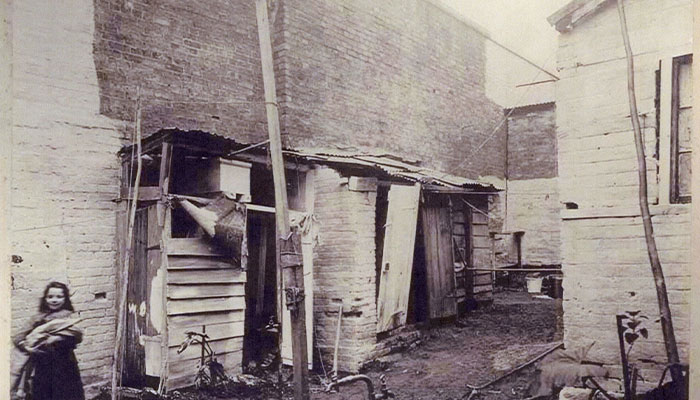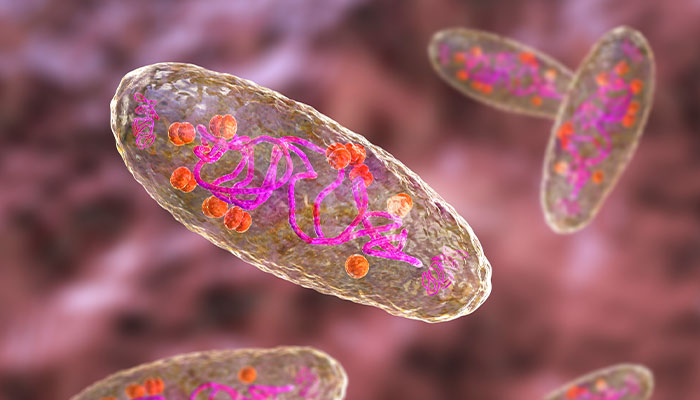We tend to think of the Black Death as a disease consigned to distant history and faraway countries, but Sydney had its own outbreak of bubonic plague in 1900, and it wasn’t an isolated incident.

Fear and suffering: The black death cut a swathe of death through Europe, and killed hundreds in Australia.
Emeritus Professor Peter Curson, from Macquarie University’s Department of Health Sciences, has a long-standing interest in how infectious diseases spread, and how ordinary people react and behave when confronted with epidemic.
“The plague probably arrived in Sydney the same way it arrived in many other countries: with rats on ships,” he says.
The disease is caused by Yersinia pestis, a bacteria carried by rats and transferred to humans by flea bites. It has appeared regularly throughout the ages, including huge epidemics that cut a swathe of death and suffering across Europe in the 1340s and 1660s.
As the plague spread, hysteria, fear and panic reached a level never before seen in Australia.
Symptoms include fever, aches and pains, nausea and vomiting, and swollen and blackened lymph nodes in the neck, groin or armpits. While it is now readily treatable, in the days before antibiotics, often at least half of those infected died.
Australia’s outbreaks were part of the last great pandemic of the Black Death, which began in China in the 1890s and spread around the world.
Only 303 cases and 103 deaths were officially recorded in Sydney’s first brush with plague, but it is believed the numbers may have been under-reported.
Australia endured 10 major outbreaks between 1900 and 1922, with a total of 1370 cases and 535 deaths, mostly in NSW and Queensland. Reappearing every year or two until 1910, it vanished for a decade, returning in 1920 when the country was still recovering from the one-two punch of World War I and the Spanish flu.
Most of Sydney’s cases in 1900 were concentrated in working-class areas, especially those near the wharfs, like The Rocks, where living conditions were filthy and overcrowded, and easily as bad as the slums of any European city.
A familiar pattern
“Just as we have seen during the COVID-19 pandemic, the arrival of the Black Death saw tremendous conflicts between governments, public health bodies and the community,” says Curson, author of A Time of Terror: The Black Death in Sydney.

Slum city: The rear of 129 Gloucester Street, The Rocks, in the early 1900s. Most cases of the plague in Sydney were in wharfside areas such as The Rocks. Picture: State Library of NSW.
“As the plague spread, hysteria, fear and panic reached a level never before seen in Australia. Schools and businesses were shut, barricades went up to close off affected areas and entire streets were forcibly quarantined.
“Sydneysiders fled the city if they could afford to, with reports of train platforms packed with passengers fighting to get to the Blue Mountains.
“Ordinary people had no confidence in the government’s ability to protect them, and in among all of this, they searched for scapegoats. It’s part of human nature to try to reduce that anxiety and fear by fixing on a visible enemy.”
Government, most of the population, and even many doctors believed it was carried in bad air and transferred from person to person.
As with outbreaks of the plague throughout history, immigrants were the first target. Chinese people bore the brunt, just as they had during previous epidemics; they were abused and assaulted in the street, and had their property vandalised.
More than 2000 cases and contacts were sent to the North Head Quarantine Station, often on such shaky grounds as a neighbour saying they didn’t look well.
Plague-ridden areas were thoroughly cleaned, but it wasn’t uncommon for someone to be released from quarantine only to find their house had not simply been disinfected, but demolished.
The head of the NSW Board of Health, John Ashburton-Thompson, knew the disease was spread by bites from rat fleas, but the idea wasn’t widely accepted.
“Government, most of the population, and even many doctors believed it was carried in bad air and transferred from person to person,” Curson says. “This was a ‘dirt disease’ associated with poverty and squalor, and Ashburton-Thompson was widely mocked for his ‘war on rats’.”
The lessons of history
With so many similarities between the outbreak of plague and the current pandemic, Curson says there is much Australia could still learn from 19th and 20th century epidemics in terms of how communities respond to risk and infection.

Culprit: The disease known as black death is caused by Yersinia pestis, a bacteria carried by rats and transferred to humans by flea bites.
“Australia has lived through 30 major epidemics and 20 pandemics since European settlement, but they are largely forgotten today,” he says.
“In 1900, the government was also at odds with people who didn’t believe their businesses needed to close, or that quarantine was necessary.
“It’s important to remember that people are afraid in these situations. They’ll believe rumours and misinformation, and look for someone to take out their frustration on.
“The challenge is to not only respond to the outbreak but to understand how ordinary people regard risk and how fear can come to dominate ordinary lives.
“I think we’ve seen many governments make that mistake in the past, whether that was 100 years ago or one year ago.”
While treatable in its current form, the plague has by no means disappeared. It lives on in wild animals in parts of Asia, Africa and even the United States, where it is found in squirrels, prairie dogs and marmots.
It is just one of the many diseases, known or undiscovered, found in animal populations around the world, and this is a fact Curson says we would do well to remember.
“As COVID-19 and monkeypox have both shown us recently, when we intrude on the natural environment, we may be confronted with a disease that has existed in animals for centuries and is suddenly able to make the jump to humans,” he says.
“We assume we’re the masters of the world we live in, but we’re not.
“The biological environment has the ability to change, mutate and intrude, and it will continue to do so.”
is an Emeritus Professor with Macquarie University’s Department of Health Sciences. His book, , is available now.






